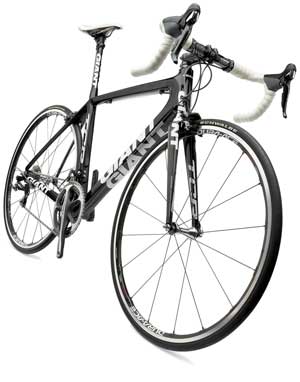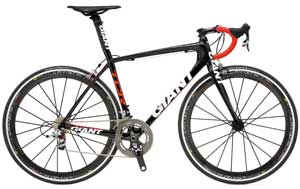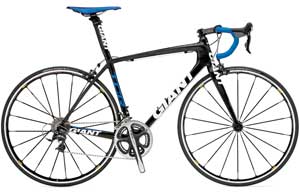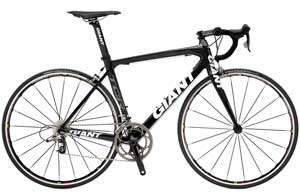2009 is going to be a big year for Giant. Not only is the company enjoying great publicity with the Columbia team on the pro race scene, but the company can finally reveal new race bikes which have been several years in development.
TCR Advanced SL
The revised range is spearheaded by the flagship TCR Advanced SL, the evolution of the Advanced RCUK tested last year. The new SL is a bike that’s been getting in loads of miles underneath the Columbia pro riders in the recent Tour de France, with Mark Cavendish piloting one to much success.
It’s clear Giant’s brief for the new SL has been to make it stiffer, because even just a casual look at the frame reveals a significantly oversized affair. The first step to achieving this increased stiffness is an oversized headtube, with a 1 1/4in lower diameter tapering to 1 1/8in at the top, with a new fork plugged into place. The downtube is now substantially larger than before, with a rectangular profile and it’s nearly 80mm across at the bottom bracket. The top tube has also been radically reshaped, with a trapezoidal profile and tapering from large at the headtube to skinny at the seat tube. Both tubes also wrap around the headtube for lots of overlap to ramp up the stiffness factor.
The next step in increasing stiffness is an oversized bottom bracket. Here Giant have fitted an 86mm wide BB shell that accepts bearing cups pressed directly into the shell, something we’re seeing more and more often – it won’t be long before every manufacturer has adopted this design somewhere in their range. Behind the bigger BB asymmetric chainstays are massive when compared to the previous bikes, and taper towards the aluminium dropouts.
The integrated seatpost remains but has had excess material shaved away to shed 40g, and it’s visibly slimmer at the point where it meets the top tube. The saddle clamp has been redesigned and can offer either 10 or 23mm of offset.
Toray T-800 carbon, the highest calibre of carbon fibre available to Giant, is used for the frame. Giant makes the top tube, headtube and downtube as a single section, and the seat tube, chainstays and seatstays as another separate monocoque, but it’s the process used to join the halves that is new. “Fusion Process” sees the tubes at the seat tube junction precisely mitered and the joint then wrapped, as in a tube-to-tube process, but the novel step is to place of the frame back inside a mould and baking it all again.
Giant is one of the few companies that can claim to have complete and total control over every production step of a frame, from the raw fibres to the moulding. Dennis Lane, Giant Global Product Development Director says: “While many bike brands farm out production to outside factories, Giant has complete control over the entire process—from design to engineering and manufacturing.”
The result of all this reworking is an increase in the stiffness factor of some 42%, though RCUK is waiting to throw a leg over a test bike before verifying this claim.
TCR Advanced
But there’s more, lots more. Giant’s more affordable Advanced has seen many changes too. Much of the new development seen on the SL has been watered down for the Advanced, but it’s no less capable of performing to a high-standard and no less impressive.
A lower grade of carbon fibre, T-700, is employed in the frame, and the same 1 1/8in to 1 1/4in headtube for increased stiffness and weight loss features at the front, and the same press-fit 86mm wide bottom bracket features. A more standard construction process is used to join all the tubes though and the result is a frame that only weighs around 140g more, though slightly less stiff than the SL. A standard seatpost design makes it slightly more versatile.
Next week: We look at the new Defy performance bikes, TCR Alliance, Trinity time trial bikes and the Avail and Aeryn women’s bikes…










